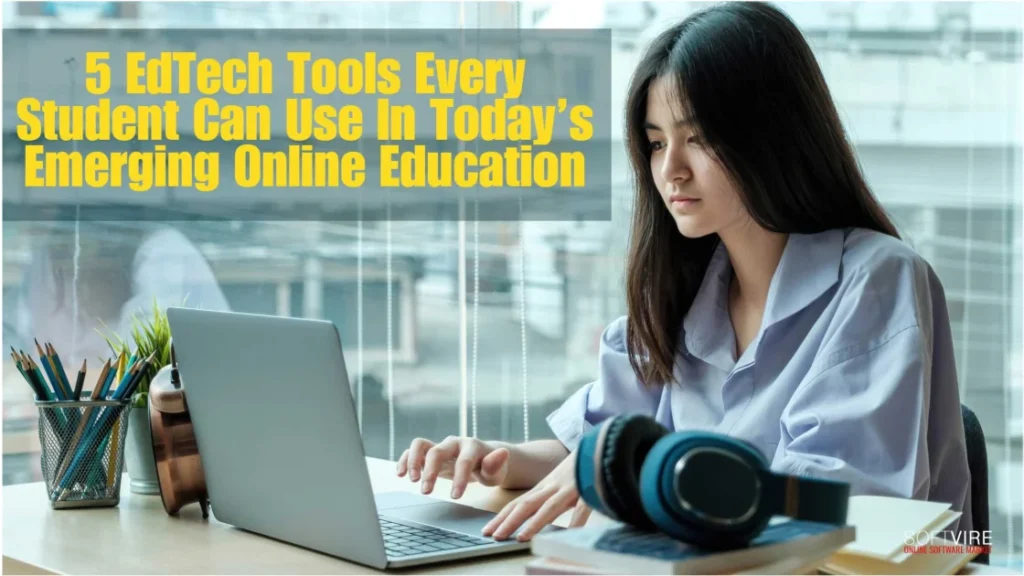Nowadays, most young individuals and senior professionals rely primarily on technology. In an increasingly digital world, there is practically no way to avoid technology in its many forms and applications—and rightfully so, because it is highly beneficial and can help us better our capacities and achieve bigger things.
That is one reason every child should have access to various electronic resources to help them study at home and within the classroom.
Here is a list of essential edtech tools that should be in every teacher’s toolbox this year, whether used for personal learning or as instructional tools in the classroom. Some of these applications are becoming increasingly well-known and extensively utilized.
Benefits of Digital Tools
Edtech tools for students offer myriad benefits that significantly enhance the learning process and academic experience. Here are some key reasons why these tools are invaluable for students:
- Accessibility: Digital tools provide students with access to educational resources anytime, anywhere. Whether studying at home, in a coffee shop, or on the go, students can seamlessly access learning materials, collaborate with peers, and communicate with instructors using their devices.
- Flexibility: Online learning platforms and digital technologies allow for scheduling and learning at your own speed. Students may access course materials whenever they choose, enabling them to balance their academic endeavors with other responsibilities like employment, family, or extracurricular interests.
- Personalization: Many digital tools employ adaptive learning algorithms that personalize the learning experience based on each student’s needs and preferences. Through targeted assessments, customized recommendations, and adaptive content delivery, students can receive tailored support to effectively address their strengths and weaknesses.
- Collaboration: Digital technologies help students collaborate on projects, exchange materials, and offer feedback in real time. Whether through virtual classrooms, online discussion forums, or collaborative document editing platforms, students can engage in meaningful interactions that foster teamwork and peer learning.
- Engagement: Interactive features such as multimedia content, gamification elements, and interactive exercises enhance student engagement and motivation. Digital technologies provide immersive learning experiences that captivate students’ attention and promote active engagement, resulting in greater understanding and retention of course information.
- Feedback and Assessment: Digital tools streamline the process of providing feedback and conducting assessments, enabling instructors to track student progress more efficiently and provide timely guidance. Automated grading systems, peer review functionalities, and data analytics tools empower educators to identify areas for improvement and offer targeted support to individual students.
- Resource Accessibility: Online libraries, digital textbooks, open educational resources (OER), and multimedia learning materials enhance the accessibility of educational resources for students, regardless of their geographic location or socioeconomic background. Digital tools democratize access to quality education and promote inclusivity in learning.
- Preparation for the Future: In today’s digital age, proficiency with digital tools and technology is essential for success in both academic and professional spheres. By incorporating digital tools into their learning routines, students develop valuable digital literacy skills that are increasingly in demand in the modern workforce.
Top 5 EdTech Tools Every Student Should Have
Microsoft Office 365
Office 365 Home is a cornerstone in educational technology, offering applications catering to various academic needs and an efficiency tool for work at home. From crafting polished Word documents to creating dynamic PowerPoint presentations, it gives students the essential tools for academic success.
One of Office 365’s standout features is its cloud-based nature. It allows students to access their documents, spreadsheets, and presentations from any device with an internet connection. This flexibility ensures seamless collaboration among group members, enabling them to work together on projects regardless of their physical location.
Additionally, Office 365 integrates seamlessly with other Microsoft services, such as OneDrive and Teams, further enhancing productivity and communication within educational settings.
Google Workspace
Similar to Office 365, Google Workspace offers a suite of productivity tools tailored to the needs of students and educators. With applications like Google Docs, Sheets, and Slides, students can collaborate in real-time, editing documents together and providing instant feedback. Google Workspace’s intuitive interface and robust sharing features make it invaluable for group projects and virtual classroom discussions.
Moreover, Google Workspace promotes efficient organization with features like Google Drive, where students can securely store and access their files from any device. Integrating Google Meet facilitates virtual meetings and lectures, fostering engagement and interaction among students and instructors. Overall, Google Workspace is a comprehensive solution for students seeking to streamline their academic workflows and collaborate effectively online.
Khan Academy
Khan Academy offers a wealth of educational content across various subjects for students looking to supplement their coursework with additional resources. From mathematics and science to humanities and test preparation, Khan Academy provides interactive lessons, practice exercises, and instructional videos to support self-paced learning.
One of Khan Academy’s critical strengths is its adaptive learning technology, which personalizes the learning experience based on each student’s strengths and weaknesses. Students can reinforce their understanding of challenging concepts and track their progress through targeted practice and tailored recommendations. Furthermore, Khan Academy’s extensive library of resources is free, making it accessible to students from all backgrounds.
Quizlet
Effective studying is essential for academic success, and Quizlet offers students a range of interactive tools to enhance their learning experience. Quizlet transforms traditional study sessions into engaging and dynamic activities with features like flashcards, quizzes, and interactive games.
One of Quizlet’s standout features is its user-generated content, which allows students to create their study materials or access existing resources shared by peers and educators. This collaborative aspect fosters a sense of community among learners, as they can support each other in mastering course content. Additionally, Quizlet’s mobile app enables students to study on the go, maximizing productivity and efficiency in their learning endeavors.
Zoom
In the era of online education, virtual communication platforms like Zoom have become indispensable tools for facilitating remote learning experiences. With features such as video conferencing, screen sharing, and breakout rooms, Zoom enables instructors to conduct engaging and interactive classes in a virtual setting.
For students, Zoom provides:
- A platform for attending lectures.
- Participating in discussions.
- Collaborating with peers on group projects.
The ability to communicate face-to-face, albeit virtually, fosters a sense of connection and community among students, mitigating the challenges of distance learning. Moreover, Zoom’s recording feature allows students to revisit class sessions at their convenience, reinforcing their understanding of complex topics and ensuring they never miss a lecture.
Why is Digital Education Important?
As you have grasped the importance of digital education in today’s society, it is critical to understand why everyone is rushing to embrace it. So, take a basic example: technology is fast progressing, and as a result, many organizations, institutions, and colleges are turning to digital platforms for education.
Online learning and education provide more access to learning resources, efficient learning and teaching techniques, and a more participatory and immersive experience. They give students various materials and tools, including online lectures, Animated PowerPoint presentations, e-books, and webinars. They also provide speedier access to material and the option to attend courses at the student’s pace.
Online education may also provide a more immersive learning experience using interactive virtual and augmented reality tools. Teachers can better assess student progress and make comments when they teach in virtual form. They may monitor students’ performance and use digital technologies to give tailored feedback and teaching. This method allows for higher levels of engagement, which can result in better learning results.
Finally, digital education is significant because it allows easier access to learning resources, more efficient learning and teaching techniques, and more interactive and immersive experiences. It is transforming how we learn and is critical to future success.
Final Thoughts
The landscape of online education is continually evolving, driven by advancements in edtech industry trends. By leveraging tools like Microsoft Office 365, Google Workspace, Khan Academy, Quizlet, and Zoom, students can enhance their learning experience, collaborate effectively with peers, and achieve academic success in today’s emerging digital era.
As technology continues to shape the future of education, embracing these EdTech tools empowers students to thrive in an increasingly interconnected and dynamic learning environment.
To know more about edtech, visit us at Softvire Global Market, and you can also get your Microsoft digital products, physical boxes, and digital licenses we have on sale to make your purchase more worthwhile.



